 |
CLASSIFICATION OF THE EASTERN SUBTERRANEAN TERMITE |
 |
Phylum: Arthropod
Class: Insect
Order: Isoptera
Family: Rhinotermitidae
Genus/species: Reticulitermes flavipes |
 |
Each year termites in North America cause billions of dollars of damage to residences as well as other facilities. Termites are often a silent and invisible pest that can cause extensive damage. This damage can be visible, not visible or both. The subterranean termite is the most common group of termites found in New York State. These termites emanate from the soil. To determine the extent of a termite infestation it is best that a trained and licensed pest management professional conduct an inspection for you.
Subterranean termites have existed for millions of years due to the fact that they are social insects. These insects live in family groups called colonies. A colony consists of three castes: |
 |
  |
Worker: These termites are creamy white in color and do not possess any wings or eyes. The mouthparts are rigid, therefore making them responsible for any damage. Termites can consume a wide variety of objects, primarily for food. The objects have one thing in common, cellulose, their nutritional component. Workers are also notorious for constructing termite shelter tubes. |
 |
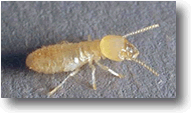 WORKER |
 |
  |
Soldier: The head is yellowish-brown in color. It contains a pair of mandibles used for defense and protection of the colony. The soldier is unable to feed itself, so it must rely on the workers for nourishment. Soldiers do not possess any wings or sight. |
 |
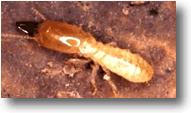 SOLDIER |
 |
  |
Reproductive: This caste generates all of the offspring in a termite colony and consists of two types:
1. Primary Reproductives: In mature colonies they will produce a large number of winged termites called swarmers. These termites are known for losing their translucent colored wings and then linking up with a mate. This is the only caste that possesses vision. The swarmers will emerge in early spring, usually indicating an active termite infestation.
2. Supplementary Reproductives: They are light in color and never develop wings. In a colony, if the king or queen should die these individuals will replace them to continue the reproduction phase. |
 |
|
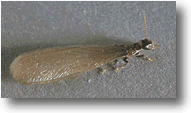 SWARMER |
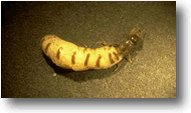 QUEEN |
|
 |
Sometimes termites are mistaken for flying ants. The picture below will help you distinguish the difference between the two. |
 |
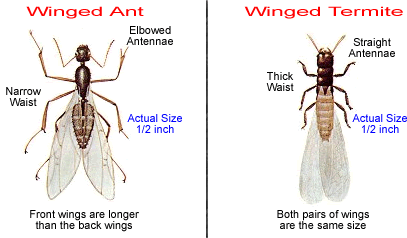 |
 |
SOLUTIONS TO YOUR TERMITE INFESTATION |
 |
Termite Treatments include a warranty. |
 |
 termite control solutions will benefit YOU: |
 |
  |
We assess each home on an individual basis. |
  |
We create an innovative termite control program that will best suit your needs. |
 |
Your termite control options are as follows: |
 |
All termite applications are performed with your familiesâ safety and the safety of your environment in mind. |
 |
  |
Termite Baiting: Focuses on using a small amount of an active ingredient to knock out populations of termites foraging in and around a structure. Baits can be used as a stand alone treatment or in conjunction with a chemical barrier treatment. Termite baits consist of paper, cardboard or other suitable termite food. This food is then combined with a slow-acting material lethal to termites. Bait stations can be installed below ground while others can be installed above ground in the path of the termite shelter tube(s). Inspecting and monitoring are key elements in the baiting process. Baiting reduces the amount of pesticide being applied. |
 |
|
|
 |
  |
Chemical Barrier Treatment: This treatment is also known as a soil treatment. The principle of a soil treatment is to create a treated barrier of soil between the wood in the structure and the colony in the soil. A chemical barrier will eliminate and/or repel any termites that pass through it. The material that is used is in liquid form and known as a termiticide. Treatments involve applying termiticide to the soil adjancet to or beneath the structure. For long term protection and control, Bora-Care® can be used in conjunction with a chemical barrier treatment. After the application, Bora-Care® will penetrate into the grain of the wood eliminating termite infestations. This product will also eliminate wood as a food source and protect the wood as long as it is in service. To determine what products are going to be used and the method of application, a termite inspection and estimate needs to be conducted first. |
 |
|
We offer two types of termiticide for the prevention and control of subterranean termites: |
 |
|
1. Talstar® Termiticide/Insecticide (repellant termiticide): contains no odor, prevents termites from crossing the chemical barrier and eliminates them on contact. Since Talstar® Termiticide has a low volatility you will not be exposed to calculable airborne residues at the completion of the treatment. |
 |
|
2. Phantom® Termiticide-Insecticide (non repellant termiticide): contains an odor similar to latex paint. The soil stability of this termiticide is excellent. It also has exceptional residual performance and control. |
 |
|
PLEASE BE ADVISED THAT STRUCTURAL MODIFICATION
MAY BE NECESSARY FOR THE PREVENTION AND CONTROL OF TERMITES. |
 |
|
For more information please contact us. |
 |